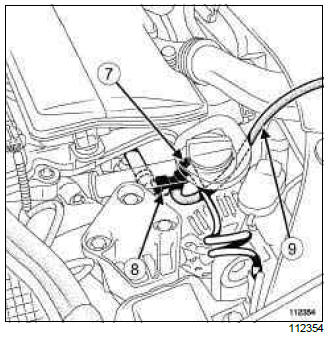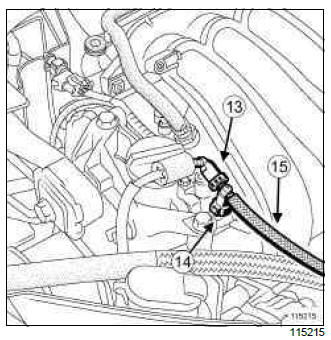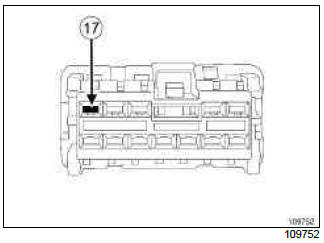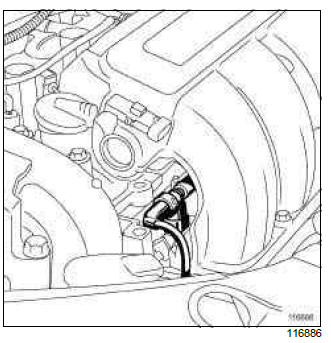Renault Clio: Fuel flow: Check
D4F or K4J or K4M or M4R

IMPORTANT
During this operation, be sure to:
- be careful of fuel splashes when disconnecting the union.
IMPORTANT
Wear goggles with side protectors for this operation.
IMPORTANT
Wear leaktight gloves (Nitrile type) for this operation.
WARNING
To avoid any corrosion or damage, protect the areas on which fuel is likely to run.
CHECK
K4J

- Disconnect the fuel inlet union (1).
- Fit a " T " union (Mot. 1311-08) (2).
- Fit to the " T " union outlet (Mot. 1311-08), a pipe (3) which is long enough to drain the pump into a container.
K4M

- Disconnect the fuel inlet union (4).
- Fit a " T " union (Mot. 1311-08) (5).
- Fit to the " T " union outlet (Mot. 1311-08), a pipe (6) which is long enough to drain the pump into a container.
D4F, and 740 or 742 or 764

- Disconnect the fuel inlet union (7).
- Fit a " T " union (Mot. 1311-08) (8).
- Fit to the " T " union outlet (Mot. 1311-08), a pipe (9) which is long enough to drain the pump into a container.
D4F, and 784 or 786

- Disconnect the fuel inlet union (10).
- Fit a " T " union (Mot. 1311-08) (11).
- Fit to the " T " union outlet (Mot. 1311-08), a pipe (12) which is long enough to drain the pump into a container.
M4R

- Disconnect the fuel inlet union (13).
- Fit a " T " union (Mot. 1311-08) (14).
- Fit to the " T " union outlet (Mot. 1311-08), a pipe (15) which is long enough to drain the pump into a container.
- Insert the pipe into a graduated measuring cylinder (2000 ml).
- Remove the Protection and Switching Unit cover.

- Remove the brown 12-track connector (16).

- Connect the terminal (17) of the brown connector to a + battery supply to operate the fuel pump.
Note: The flow reading should be 80 to 120 l/h.
- Removal the terminal (17) of the brown connector from the + battery supply.
- Refit the Protection and Switching Unit cover.
- Disconnect:
- the petrol inlet duct on the " T " union (Mot. 1311- 08),
- the " T " union (Mot. 1311-08) on the rail,
- the discharge pipe.
- Connect the fuel inlet pipe on the injector rail.
F4R

IMPORTANT
This procedure must be carried out with the ignition off.
IMPORTANT
During this operation, be sure to:
- beware of fuel splashes when disconnecting the union,
- protect sensitive areas from fuel outflow.
IMPORTANT
Wear gloves during this operation.
IMPORTANT
Wear goggles with side protectors for this operation.
I - REFITTING PREPARATION OPERATION BEFORE CHECK
- Use the (Mot. 1311-01) and the (Mot. 1311-08).
- Assemble the long flexible pipe of the (Mot. 1311- 01) and the (Mot. 1311-08).
- Disconnect the fuel supply union on the injector rail.

- Pass the flexible pipe of the (Mot. 1311-01) fitted with the (Mot. 1311-08) under the inlet manifold.

- Connect:
- the (Mot. 1311-08) onto the injector rail positioning it between the rocker cover and the inlet manifold then pivoting it,
- the fuel supply union on the (Mot. 1311-08).
II - FUEL FLOW CHECK
- Insert the flexible pipe in a graduated measuring cylinder (2000 ml).
- Remove:
- the soundproofing unit,
- the UPC cover.

- Disconnect the brown 12-track connector (1).

- Connect terminal (2) of the brown connector to a + battery supply to operate the fuel pump.
Note: The flow reading should be 80 to 120 l/h.
- Remove the + battery feed brown connector terminal .
III - FINAL OPERATION
- Refit:
- the UPC unit cover,
- the soundproofing unit.

- Disconnect the fuel supply union on the (Mot. 1311- 08).
- Disconnect:
- the fuel supply union of the (Mot. 1311-08),
- the (Mot. 1311-08) from the injector rail.
- Remove the flexible pipe of the (Mot. 1311-01) fitted with the (Mot. 1311-08).
- Separate the (Mot. 1311-01) from (Mot. 1311-08).
- Connect the fuel supply union on the injector rail.
READ NEXT:
 Diesel injection: Precautions for the repair
Diesel injection: Precautions for the repair
K9K
I - RISKS RELATING TO CONTAMINATION
The high-pressure direct injection system is highly sensitive
to contamination. The risks caused by contamination
are:
damage to or destruction of the high pr
 Diesel injection: List and location of components
Diesel injection: List and location of components
K9K, and 750 or 760 or 762 or 764 or 766 or 768
High pressure pump
Flow regulation solenoid valve
Pressure regulation solenoid
valve
Diesel temperature sensor
Spacer between the cylinder
head
SEE MORE:
 Front door sill lining: Removal - Refitting
Front door sill lining: Removal - Refitting
B85 or C85
REMOVAL
I - REMOVAL PREPARATION OPERATION
Partially remove the seal (1).
Using a pair of unclipping pliers, unclip the bonnet release catch (2).
II - OPERATION FOR REMOVAL OF PART
CONCERNED
Unclip the trim at (3) and (4).
Remove the trim (5).
C85
Unclip the trim at (6) and
 Bodywork maintenance
Bodywork maintenance
A well-maintained vehicle will last
longer. It is therefore recommended to
maintain the exterior of the vehicle regularly.
Your vehicle has been treated with very
effective anti-corrosion products. It is
nevertheless subject to various outside
influences.
Corrosive agents in the atmospher
© 2016-2025 Copyright Renault Clio Owners Club

